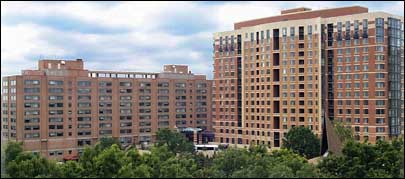Goodwin House Alexandria is one of two faith-based retirement communities with independent- and assisted-living facilities in northern Virginia, owned by Goodwin House Inc.. The organization is providing an RFID-based service that enables residents to signal for help, then automatically provides staff members with the caller’s name and location.
The service is enabled by technology from Healthsense, a Mendota Heights, Minn., aging-services technology firm, and Ekahau, a provider of a Wi-Fi-based real-time location system (RTLS).

Healthsense’s service, known as eNeighbor, is designed to provide residents with security and access to help in a non-intrusive manner. The eNeighbor system comprises a variety of Wi-Fi-based RFID devices that residents can use to summon help, including a pendant they can wear around their necks, and pull cords that can be affixed to walls. Other options include RFID-enabled bed and chair sensors that can detect, for instance, when a resident has gotten into and out of bed, as well as motion sensors to discern movement within a residence. The eNeighbor solution depends on Wi-Fi gateways, or access points, that receive communications from the various Wi-Fi devices and pass that information along to back-end software—a Web-based system hosted by Healthsense at one of two data centers in Minnesota and Colorado—that then generates alerts. The solution also includes the Ekahau Positioning Engine (EPE) software, which calculates locations.
Goodwin House Alexandria began utilizing the RTLS in August 2008. Since then, 150 of its 320 residents that live in the on-site apartments (another 80 reside in a continual-care facility at that same location) have opted to use the system. After paying a one-time fee of $150, a resident receives a pendant containing a Wi-Fi-based active RFID tag that features an emergency call button. When the button is pressed, its Wi-Fi tag emits a signal encoded with the tag’s unique ID number that is correlated in a database with the resident’s name and apartment number. Nearby access points pick up the signal and send it along to the back-end system, where the EPE software determines location—in this case, a zone averaging approximately 60 square feet in size—and the eNeighbor software identifies the resident based on the tag’s unique ID number.
The eNeighbor solution, which has text-to-speech capabilities, then triggers a cellular call to supervisors’ wireless phones. The call informs the supervisors of the resident’s name and apartment number, as well as the specific zone in which the signal originated, and a supervisor can then instantly dispatch help. Upon receiving an alert, employees go to the zone first, in case the resident called for help from somewhere other than his or her apartment.
Goodwin House Alexandria has also installed pull cords extending all the way to the floor that residents can pull if they fall. The cords have been installed in all residents’ bathrooms, as well as in shared bathrooms in common areas, according to David Fowler, the organization’s IT director. While residents pay for the pendants, the pull cords are available free of charge. The cords work similarly to the pendants: When the cord is pulled, a Wi-Fi RFID tag begins emitting its signal. There are 257 access points installed at the retirement community, which provide coverage throughout the apartments, as well as the common and outdoor areas.
“This is a pretty important benefit of this system,” says Colleen Mallon, Goodwin House Alexandria’s corporate director of marketing. “Our community is huge. There are two buildings, one with 15 floors and another with 12 floors, and there are outdoor living areas. With a lot of systems like this, the pendent only tells which apartment the call may have come from. But if the resident isn’t in the apartment, you could be looking for a while. This system really tells you where the resident is.”
Another important feature of the real-time location system is its back-up system: a cellular modem that kicks in if the Internet server goes down, so that alerts can be transmitted through to Healthsense’s hosted software, and then be sent out to supervisors’ phones.
Since installing the RTLS, several residents have already had to use it. “A lot of residents go outside and walk,” Mallon states, “and we have had residents who have fallen outside their apartments, and they’ve said to us how relieved they were, knowing we would be able to find them.” Approximately one month ago, she adds, one resident fell in the community’s garage and was able to use a pendant to summon help immediately.
“They could have been in there for hours before someone would have found them,” Fowler says. “With this [RFID system], we were able to get help to them within a few minutes.”
The RTLS also has an added bonus: It has provided Goodwin House Alexandria with a comprehensive wireless infrastructure that residents can use to gain Internet access. “That was one of the big selling points,” Mallon says. “We were basically going to get a free wireless network. The saturation of wireless access points is tremendous—much more than what you would need if you were just to provide wireless Internet access.”
What’s more, the system may allow the retirement community to offer additional services, including community-based services that support the elderly who prefer to live in their own private homes. “We have a waiting list, and we’ve toyed with the idea of offering services into individual homes,” Mallon says. “Healthsense allows us to put monitoring systems into individual homes.”
Goodwin House Alexandria indicates it will consider installing the RTLS at its other community, located in Bailey’s Crossroads, which is currently under renovation. Moreover, it may also consider adding some of the other Wi-Fi devices, such as bed and chair sensors.

